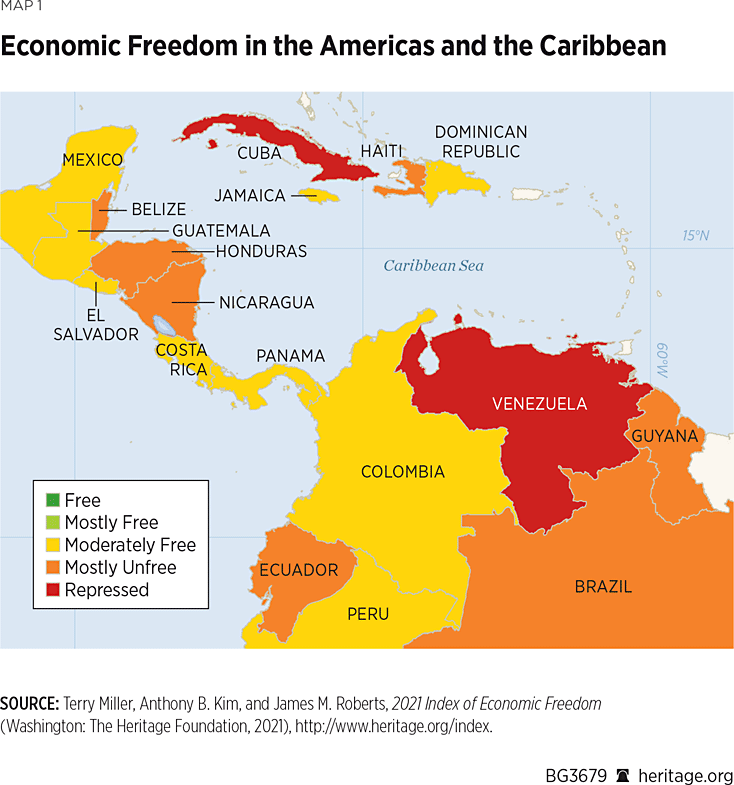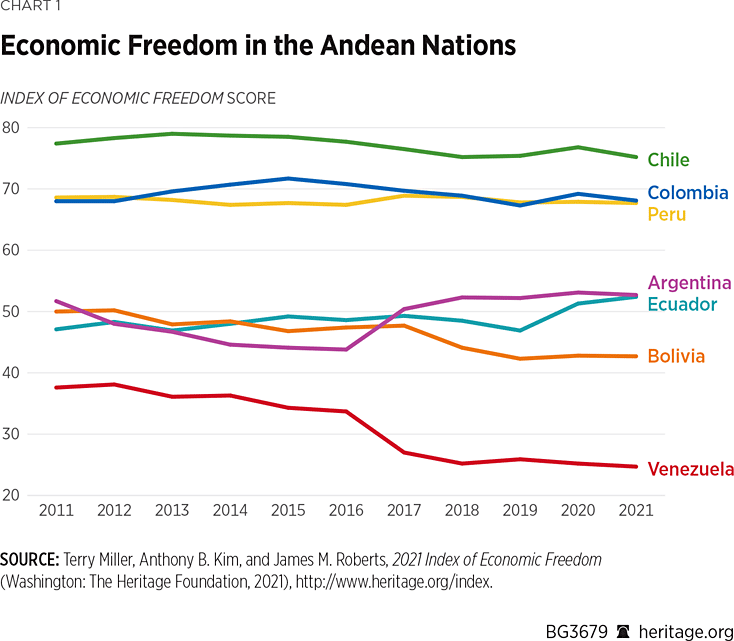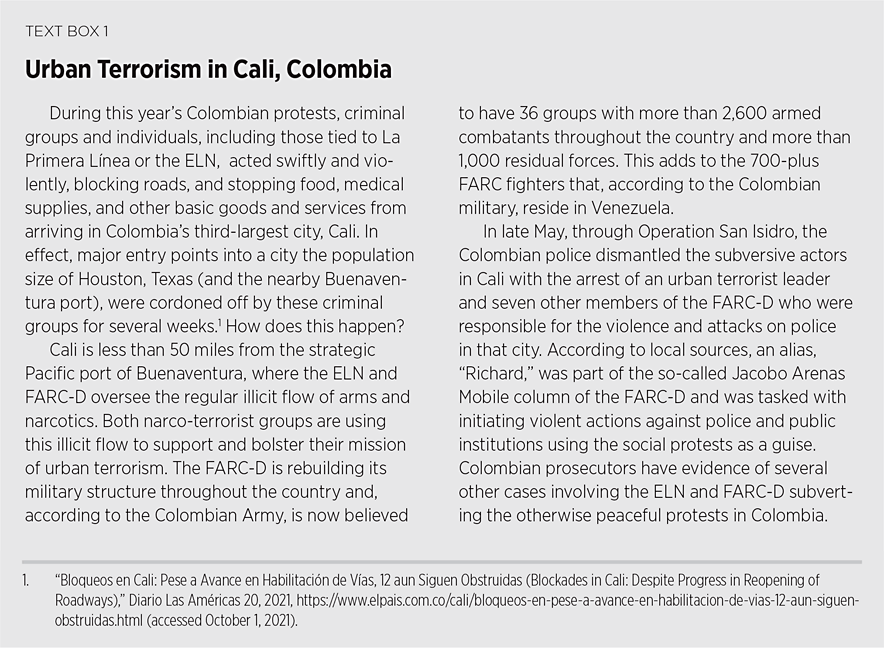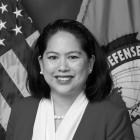Colombia is facing uncertain and troubling times. Multiple, interrelated crises—including mass social protests, serious fiscal challenges, irregular armed conflict on its border, and the COVID-19 pandemic—are destabilizing the country’s political landscape, economy, security, and society. Founded in 1810, Colombia is the second oldest democracy in Latin America, geographically well-positioned with access to the Pacific Ocean and Caribbean Sea and blessed with ample natural resources.

Underlying Conditions for Protests
With a population of approximately 50 million, Colombia has experienced previous political violence and survived almost 50 years of armed conflict with guerilla groups like the Revolutionary Armed Forces of Colombia (FARC) and the revolutionary left-wing National Liberation Army (ELN) that have resulted in over 260,000 deaths. Colombia’s shadow, illicit economy has been driven in large part by the lucrative cocaine trade, as well as illegal gold-mining and oil-smuggling operations that have sustained insurgent and other armed groups for decades.
This hidden and corrupting economy continues to flourish and fuel insecurity in Colombia, aided and abetted by the neighboring criminal regime of Venezuelan dictator Nicolás Maduro. Nevertheless, and despite these enormous challenges, Colombia’s legitimate free-market economy is thriving and ranks relatively high in the Americas region of the annual Heritage Foundation Index of Economic Freedom.REF

Unfortunately, the country also faces high levels of poverty. According to the Economic Commission for Latin America and the Caribbean (ECLAC),REF 37.5 percent of Colombians lived below the poverty line at the end of 2020. More than two-thirds of Colombian households make less than $600 USD in total monthly income.REF Colombia’s large social protests, labor strikes, and violent clashes with police made international news in April 2021, but had already been underway in November 2019, well before the outbreak of COVID-19 in the region.
These protests were similar to the social and political unrest witnessed in Bolivia, Chile, Ecuador, and Peru since 2019. In Colombia, such protests were fueled by social and economic grievances due to long-standing inequalities and high youth and female unemployment. The perceived slow implementation of the 2016 peace process with the FARC (in terms of agricultural reforms, reintegration of FARC members and transitional justice) alongside continued violence against local social leaders by illicit armed groups, have added to public discontent with a Duque Administration that has been suffering historically low approval ratings.
On April 28, 2021,REF mass protests erupted in response to the Duque Administration’s proposal to raise taxes on Colombians making 2.4 million Colombian peso (COP) or more in monthly income, an amount roughly equal to only $663 USD at the exchange rate that month.REF The logic of the proposal was to reduce Colombia‘s worsening fiscal deficit, which had resulted in international credit-rating agencies downgrading Colombian government bonds, and to sustain government spending during the pandemic, with the Colombian middle class incurring the cost. In the mass protests that followed, some of which turned violent, there were allegations of human rights violations due to heavy-handed measures used by the Colombian police to quell protests that caught the attention of the U.N. High Commissioner for Human Rights.REF
COVID-19
Without a doubt, COVID-19 has negatively impacted health, economic security, and democratic indicators in Colombia and countries around the world. Colombia has been particularly hard hit by the pandemic with one of the highest rates of COVID-19 infections and deaths in Latin America.REF It also suffered from a slow start to its vaccination process.REF
The pandemic has also seriously impacted the economy due to strict national lockdown policies resulting in a gross domestic product (GDP) contraction of –6.8 percent in 2020.REF The pandemic became a catalyst and force-multiplier for the explosion of pre-existing socio-economic grievances and the emboldening of political opponents of both the Duque Administration and democratic institutions, resulting in mass protests that paralyzed Colombian cities.
The TPA and Paz Colombia
Colombia is one of the region’s closest U.S. partners, if not the closest. Both countries share a commitment to democratic values, human rights, and free-market capitalism and have mutual security interests. The U.S. is also Colombia’s largest trade and investment partner, due in part to the U.S.–Colombia Trade Promotion Agreement (TPA) that was implemented in 2012, with a two-way goods trade of $29 billion and a services trade of $11.7 billion in 2019 alone.
Colombia is also a leader in Latin America and has generously welcomed more than 1.8 million Venezuelans fleeing the Maduro regime, while providing economic and security assistance to its neighbors. Colombia has provided know-how on security across the region, traini ng thousands of military and police personnel from Central and South American countries.REF Notably, this included Colombia’s participation in the Merida Initiative in Mexico, which became critical to security within Mexico and at the U.S. southern border.REF
Through Plan Colombia—a mutual security agreement and military assistance program now called Paz Colombia—in which the U.S. invested over $10 billion between 2000 and 2016, the U.S. and Colombia have built a strong counterterrorism and counter-narcotics partnership to combat the cocaine trade and armed groups such as FARC and ELN.REF
Plan Colombia was launched in 2000 under U.S. President Bill Clinton and Colombian President Andrés Pastrana. It was largely implemented under the subsequent administrations of U.S. President George W. Bush and Colombian President Álvaro Uribe in the early 2000s. In this process, Colombia went from the potential of a failed state (having substantial portions of its vast territory under control by FARC and ELN terrorist groups) to an example of security and democracy in the region.
Although FARC signed a peace deal with the Colombian government in 2016, following the successes of Plan Colombia—and despite the objection of a majority of voters in a national plebisciteREF—FARC dissidents and the ELN are now regrouping and growing in numbers.REF In November 2021, the Biden Administration removed FARC from the State Department’s list of Foreign Terrorist Organizations. Although FARC has formally demobilized, its leadership has not yet been subject to the Colombian justice system, and the growth of dissident groups continuing to pursue illicit activity has been rapid and often difficult to track.REF The Administration added just two dissident groups to the list,REF but the blanket removal will no doubt leave a wide number of individuals and groups prematurely free of the designation.
A Vital American Partner, Targeted by Enemies of Freedom
Colombia’s rich agricultural land and geostrategic location have remained both blessings and curses. The climate and topography are perfect for growing coffee beans and coca leaves. Unfortunately, the latter continues to drive an overpowering illicit economy of cocaine trafficking.
For decades, both local and international actors have set their sights on Colombia in attempts to dismantle its democratic institutions.
FARC-D and ELN Dissidents. Had it not been for the leadership of President Álvaro Uribe from 2002 to 2010—and close defense cooperation with the United States—Colombia might very well be under the control of narco-terrorists today, like its neighbor Venezuela. Colombians fought back, however, and recovered their democracy from the threat of FARC, while several FARC dissidents and leaders fled to Venezuela under the protection of the Hugo Chávez (now Nicolás Maduro) regime.
Colombian Defense Minister Diego Molano reported on May 3 that at least six criminal groups were behind the acts of violence and vandalism during Colombia’s protests earlier this year.REF This includes FARC dissidents (FARC-D), the ELN, and the Blue and Black Shields of the M-19 youth movement. During the 2019 Colombia protests, these criminal groups established a modus operandi using disenfranchised youth on the front line of clashes with the Colombian police.REF
This tactic was used previously in Chile in 2019, when violent youth groups attacked the police and burned down the subway system in Santiago in response to a four-cent USD hike in public transit fares. In Colombia, as in Chile, the tactic surfaced through a group known as The Front Line or La Primera Linea. According to video footage from Colombian media outlets, La Primera Línea has received training on how to use agitation and propaganda to provoke the Colombian police into battle.REF

When groups like FARC and ELN began their assault on Colombia’s democracy in the 20th century, they were focused mostly on guerilla warfare in rural areas of the country. Today their successors have become fully bi-national narco-terrorist groups with equal presence in Colombia and Venezuela, empowered by the Maduro regime and financed by the world’s most lucrative licit (oil and gold) and illicit commodities (cocaine).
Since its tenure began in August 2018, the Duque government has been dealing with increased provocation by the Maduro regime. Colombia, however, has been the primary target of Venezuela’s national security strategy since the dawn of the Bolivarian revolution in 1999.REF In the lead up to the 2019 protests in Colombia, a subtle warning was sent by Maduro regime strongman and Venezuelan National Assembly member Diosdado Cabello, who referred to the protests as a “Bolivarian breeze” flowing from Venezuela. That “breeze” has now arrived in Colombia with gale force.REF
Venezuelan Aggression. Because of Colombia’s geostrategic location and its close ties to the U.S. both in values and in policy, Venezuela’s Chavista regime and other malign external actors have long prepared for this precise moment when Colombian institutions are at their weakest. And they have an asymmetric strategy to exploit illicit networks and illicit economies as a 21st-century vanguard to conquer the territory of its neighbor.REF
Recent reports of a potential weapons transfer between Venezuela and IranREF also raise security concerns for the hemisphere, particularly for Colombia, as the Maduro regime’s ties to illicit armed groups including Hezbollah, the ELN, and FARC-D persist.REF On May 5, during the Colombia protests, the Maduro regime’s armed forces posted an image on Twitter of the map of the Captaincy General.REF This was a reference to the “Kingdom of Venezuela” during 18th-century colonial times, an eerie inference that part of Colombia is considered territory of the Bolivarian Republic of Venezuela in the eyes of the Maduro regime.
The Battle of Digital Narratives
As explained earlier in this Backgrounder, legitimate and long-standing grievances are being expressed by the Colombian people, who have been beaten down by bad policies and the pandemic. These grievances, however, were hijacked during Colombia’s recent protests by criminal groups and external actors with other agendas. Part of their agenda is to distort the international narrative to delegitimize the Duque government and sow divisions within Colombian society.
This is not unique to Colombia.
Elsewhere in South America, one study showed that less than 1 percent of users on social media generated almost one-third of the content related to the 2019 protests in Chile, fueling the violence that resulted in multiple violent attacks against various institutions in Santiago.REF Most of that 1 percent of users fanning the flames on the streets of Santiago were not from Chile: They were Venezuelan.
A similar effort seems to be underway in Colombia, where private artificial intelligence firms discovered troll accounts managed by click farms located as far away as Bangladesh. A Bangladeshi, for example, might earn as little as $120 per year—making these disinformation efforts cost-effective.REF
Through increasingly sophisticated click farms and net centers, trolls and bots are spamming social media to exacerbate otherwise peaceful protests—steering them toward violence and spreading false narratives. This high-level use of disinformation by anti-American state and non-state actors is undermining legitimate grievances and threatening the rights of citizens to peaceful assembly.
China, Russia, and Other Malign External Actors
The interests of external state actors in Colombia are becoming increasingly clear. The growing presence of Russia, China, and Iran in Venezuela—and increasingly in Colombia—is a direct challenge to the U.S.–Colombia partnership and has profound implications for regional security.
Russia. According to Colombian security officials, the Russian military intelligence services have been active in Colombia in recent years. In December 2020, Colombia tracked unusual movements of diplomatic personnel from the Russian embassy in Bogotá, leading to the expulsion of at least two “diplomats” in December of last year—a first in Colombia–Russia relations.REF This was followed by a Russian military aircraft violating Colombian airspace just days before the uproar of social protests began in April of this year. While the Colombian government protested the incident, repeated violations of Colombian airspace by Russian-manufactured Venezuelan military drones has added to the complexity of the conflict on the Colombia–Venezuela border.
Russia is a close partner of the Maduro regime, having sold more than $11 billion worth of armament to Venezuela since 2005. The presence of Russian military advisers and contractors has become routine in Venezuela, a presence that is complemented by China.
China. Like Russia, China has also sold armament to the Chavista regime, including providing anti-ship missiles to the Venezuelan Navy and K-8 combat planes routinely flying on the Colombia-Venezuela border. China has also installed a PLA-run satellite tracking station at the Venezuelan military airbase, Capitan Manuel Rios, in the state of Guárico.
Next door, China is steadily increasingly its political and economic influence in Colombia to complement its presence in Venezuela. In 2019, China was awarded a contract to build the Bogotá metro in a bid that did not include any U.S. companies. Through the China Harbour Engineering Company, a subsidiary of the state-owned China Communications Construction Company, China will now exercise influence over critical infrastructure in Colombia’s capital and largest city.
Another asymmetric weapon in Beijing’s arsenal is vaccine diplomacy. China’s woefully inadequate, but readily available, Sinovac coronavirus vaccine is being used as leverage in Colombia to pressure the Duque government to allow China’s telecommunications company (and direct conduit to Chinese military intelligence), Huawei, to participate in the upcoming 5G spectrum auction in Colombia at the end of 2021—a dual-track diplomatic effort that China has also initiated in Brazil. In February of 2021, as it sought access to buy Sinovac, the Brazilian government announced the rules of its 5G spectrum auction, which would now include Huawei—after previously shunning the Chinese telecommunications giant.
China is the lynchpin of recent gasoline shipments from Iran to Venezuela. Recent reports from Reuters reveal that the sanctioned logistics firm China Concord Petroleum Company (CCPC) plays a critical role in chartering ships that carry more than 20 percent of Venezuela’s total oil exports to China. This same shipping network is used to carry oil from Iran in an increasingly coordinated effort to circumvent U.S. sanctions.
Iran. Iran’s presence in Colombia, albeit much more stealth than Russia and China, has concerning aspects in terms of disinformation and potential ties to FARC-D and ELN. Last October, the Colombian military killed a top ELN commander, alias Uriel, and later cracked the more than 2 million encrypted files. After combing through the 3.2 terabytes of information, it was discovered that the ELN was reaching out to Iran for logistical and material support. This past July, the Colombian military captured another computer, this time of the FARC dissident leader known as “Gentile Duarte,” and discovered communications from 2020 stating that the Colombian narco-terrorist group had established “diplomatic” relations with Iran.REF
Colombia has become the focal point for top U.S. adversaries in the era of great-power competition. Abandoning or reducing support to Colombia does not come without unintended consequences, of which the most detrimental to U.S. national security is the likely extension of Russia, China, and Iran’s influence from Venezuela to Colombia.
Recommendations
Colombia is facing a triple crisis of mass social protests, serious fiscal and economic challenges, and the pandemic—crises that are destabilizing the political, economic, social, and security aspects of the country. The U.S. must redouble its efforts to support its closest democratic partner in the Americas region. To strengthen its partnership with Colombia as it addresses hurdles of institutional stability and post-pandemic economic fallout, the Biden Administration and Congress should:
- Strengthen security assistance to Colombia to support police and the armed forces to counter subversive actors and illicit narcotics. Security assistance should emphasize the growing instability along the shared border with Venezuela, which is increasingly exploited for the free flow of organized crime. The U.S. should signal to the Colombian government that this is a priority for the bilateral relationship and should coordinate security and intelligence efforts in critical border areas. Technological and security assistance should also take special consideration of strategic areas in Colombia, such as the Pacific Ocean port at Buenaventura and North Santander on the Colombia–Venezuela border.
- Expand trade and investment by strengthening the application of the U.S.–Colombia Trade Promotion Agreement and identifying other areas of trade cooperation. The U.S. should cooperate with Colombia’s Ministry of Commerce, Industry, and Tourism to facilitate increased trade by small and medium-sized enterprises in both Colombia and U.S. markets. This includes revisiting TPA business standards and regulatory hurdles that the U.S. does not ask of other trading partners. Shifting vulnerabilities in global supply chains and trade tensions with China also present opportunities for an expansive regional trade and investment strategy.
- Focus potential infrastructure investments on critical security and economic growth challenges, coordinating with U.S. and Western European private sectors. As the Biden Administration looks to Colombia and other Latin American countries to invest in infrastructure projects in response to China’s Belt and Road Initiative, it should focus U.S. resources on regions and urban areas that are economically isolated and vulnerable to organized crime. Investments in basic infrastructure and technology should be prioritized over a broader definition that dilutes resources. These efforts should exist alongside convening private-sector actors in the U.S. and Western Europe to provide alternatives to Chinese state-owned companies and to strategically coordinate investments.
- Help Colombia safeguard its sensitive communications, and closely monitor the growing intelligence activity of Russia in Colombia. This should also include scrutinizing Moscow’s presence in Venezuela and its use of advanced military technology and electronic intelligence near the Colombia–Venezuela border.
- Monitor and counter China’s strategy ahead of the upcoming 5G spectrum auction expected in 2022—in which Huawei has a vested interest. The U.S. should monitor the run-up to the auction process closely to assist Colombians in ensuring an ethical and market-driven process, and it should work with private-sector partners to offer Colombians a viable 5G alternative. Considerable attention should be paid to developing long-term 5G cybersecurity standards, protecting intellectual property rights, and underscoring the need to operate in a “zero-trust” environment if Huawei were to gain control of the 5G spectrum.
- Identify and assist legitimate civil society groups in Colombia to address disinformation and misinformation efforts by hostile foreign actors. This should be accompanied by a broader regional coordination effort to identify disinformation threats in Latin America’s market democracies. Past lack of coordination has enabled distorted narratives to take hold both locally and abroad, ultimately undermining the credibility of democratically elected governments. The State Department’s Global Engagement Center and the Organization of American States can help lead this effort through training programs, grants, and coordination with local civil society actors and legitimate governments across the region.
- Work closely with Colombians in their pandemic recovery efforts through both public- and private-sector coordination. Attention should be closely paid to China’s potential usage of vaccine diplomacy as political leverage. U.S. efforts may include additional donations of U.S. medical equipment and vaccine assistance. Moreover, coordination should occur directly with local governments and health officials to assess remaining challenges.
Conclusion
Colombia is one of the U.S.’s closest partners in Latin America, sharing democratic values, free-market capitalism and mutual security interests. The U.S. is Colombia’s largest trade and investment partner, thanks to the U.S.–Colombia Trade Promotion Agreement. Through Plan Colombia (now called Paz Colombia), in which the U.S. invested over $10 billion, the U.S. and Colombia have built a strong counterterrorism and counter-narcotics partnership to combat the cocaine trade and armed groups like FARC and ELN.
Colombia is a regional leader and has been very generous in welcoming over 1.8 million VenezuelansREF fleeing the Maduro regime—and providing economic and security assistance to its Latin American neighbors. As Colombia faces increased instability, the U.S. must stand by its trusted partner and its democratically elected government under President Iván Duque to ensure continued security and prosperity in Colombia and across the region.
James M. Roberts is Research Fellow for Economic Freedom and Growth in the Douglas and Sarah Allison Center for Foreign Policy, of the Institute for Family, Community, and Opportunity, at The Heritage Foundation. Mateo Haydar is Assistant for Latin America in the Allison Center. Celina B. Realuyo is Professor of Practice in the William J. Perry Center for Hemispheric Studies at the National Defense University and has achieved international recognition as an expert on Latin America. Joseph M. Humire is the Executive Director of the Center for a Secure Free Society and an internationally recognized expert on Asymmetric Warfare and Transregional Threats in the Americas.




